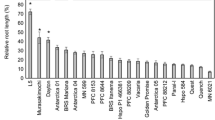Summary
Aluminum toxicity limits root growth in acid subsoils that are difficult to lime. An alternative to subsoil liming is the development of plants having greater tolerance to Al. Alfalfa (Medicago sativa L.) is considered an Al-susceptible species. Preliminary studies indicated that alfalfa cultivars differ in Al tolerance, but the extreme plant-to-plant variation within cultivars prevented the establishment of clearcut cultivar differences.
Tolerant and susceptible plants were selected from each of six cultivars (‘DuPuits’, ‘Atlantic’, ‘Team’, ‘Buffalo’, ‘Grimm’, and ‘Sirsa 9’) grown on an Al-toxic Bladen soil at pH 4.1 to 4.3. The tolerant selections were repotted and interpollinated to form one population of polycross seed. Susceptible selections were treated similarly to form a second population. These two populations, tolerant and susceptible, were subjected to an additional cycle of recurrent phenotypic selection for tolerance and susceptibility, respectively, to Al-toxic Bladen soil at pH 4.6.
Plants from the population selected for tolerance to the acid Bladen soil were significantly higher in both root and top vigor on Al-toxic Tatum soil than plants from the population selected for susceptibility. The results indicated that Al tolerance is a heritable trait in these alfalfa populations and that recurrent selection can be used effectively to develop strains having differential tolerance to Al-toxic soils. The observation that only 2% of the plants from the tolerant population were in the most tolerant class suggests a good opportunity for more progress in selecting toward Al tolerance.
Similar content being viewed by others
Literature cited
Adams F. and Lund Z. F., Effect of chemical activity of soil solution aluminum on cotton root penetration of acid subsoils. Soil Sci. 101, 193–198 (1966).
Dessureaux L., Effect of aluminum on alfalfa seedlings. Plant and Soil 30, 93–97 (1969).
Foy C. D., Effects of aluminum on plant growth. E. W. Carson (ed.) The Plant Root and its Environment. University of Virginia Press, Charlottesville, Virginia 22904 (1974).
Kiesselbach T. A., Russel J. C. and Anderson A., The significance of subsoil moisture in alfalfa production. Agron. J. 21, 241–268 (1929).
Ouellette G. L. and Dessureaux L., Chemical composition of alfalfa as related to degree of tolerance to manganese and aluminum. Can. J. Plant Sci. 38, 206–214 (1958).
Reid, D. A., Genetic control of reaction to aluminum in winter barley. pp. 409–413, in R. A., Nilan (ed.) Barley Genetics II. Proc. Second Intern. Barley Genetics Symp., Pullman, Washington, 1969. Wash. State Univ. Press (1971).
Reid D. A., Jones G. D., Armiger W. H., Foy C. D., Koch E. J. and Starling T. M., Differential aluminum tolerance of winter barley varieties and selections in associated greenhouse and field experiments. Agron. J. 61, 218–222 (1969).
Simpson, J. R., Differential root penetration into low calcium subsoils by genotypes of lucerne. Proc. Intern. Grassland Congress, June 1974, Moscow (Manuscript accepted) (1974).
Author information
Authors and Affiliations
Rights and permissions
About this article
Cite this article
Devine, T.E., Foy, C.D., Fleming, A.L. et al. Development of alfalfa strains with differential tolerance to aluminum toxicity. Plant Soil 44, 73–79 (1976). https://doi.org/10.1007/BF00016956
Received:
Published:
Issue Date:
DOI: https://doi.org/10.1007/BF00016956




